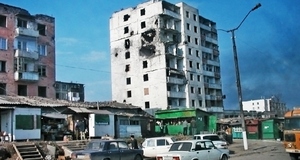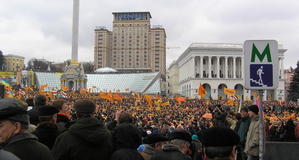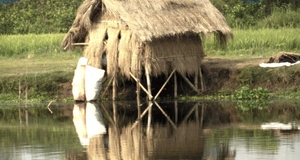From Proto-State to Para-State Accountability: Russian Political Regimes Under Yeltsin, Putin, and Medvedev
By
2012, Vol. 4 No. 09 | pg. 1/3 | »
IN THIS ARTICLE
KEYWORDS
When on September 24th, 2011 Russian prime minister Vladimir Putin announced his bid to run for president in the presidential elections in March 2012, a supposition in Russia's political regime was confirmed that many observers suspected would come true ever since the assumption of office of president Dmitri Medvedev in May 2008. With a constitutionally correct departure from the presidency, Putin still remained the influential political heavy weight in Russian politics, making Medvedev appear to be merely a pale place holder for Putin's return to the presidential driver's seat in 2012, critics held. The political regime under president Medvedev, despite bold declarations of a fight against 'legal nihilism' and the creation of a liberal, open, and investment-friendly Russia, was in effect surprisingly similar to the political regime that characterized Putin's previous presidency, with censored media, politicized state institutions, and a hardly transparent judiciary still being the order of the day. Since the collapse of the Soviet Union and the stormy years of transition under Yeltsin, Russian presidents have needed to confront the legacy of their predecessor. Yeltsin, whose historical fate it became to lead Russia's post-Soviet transition process, created a political regime whose logic and legacy explains the rationale behind Putin's fervent re-centralization process in the 2000s: developments that are dealt with in the first two parts of this paper. While Putin's political regime retained elements of the Yeltsin years with regard to the quality of democracy and civil society, it equally differed from it in important aspects of territorial-administrative and economic governance. A third part of this paper thus analyzes Medvedev's approach to Putin's presidential legacy and the ensuing political regime emerging under his presidency. While Putin's 'strengthening of the power vertical' meant a prickly legacy for Medvedev, it is the logic of 'Putinism' (Aron 2010a) that arguably holds explanatory value for Russia's current political regime, especially after Putin’s return to the presidency in 2012.Privatization and Federal Fragmentation – Years of Transition and Upheaval Under YeltsinBoris Yeltsin was faced with the challenge of managing a transition from a system that had failed economically and politically, a system that could not be saved by the first tentative reform attempts by Andropov in the 1980s nor by Gorbachev's attempt of a conservative evolution as from 1985 (Sakwa 2002: 8f.). When the Soviet Union finally crumbled under the burden of its inherent structural deficits, it was Yeltsin's historical fate to reform the system and abolish the societal and economic pillars of Soviet modernity in order to allow for a transition to a free market economy and an opening up of society. Yeltsin had established himself as a reformer during Gorbachev's perestroika policy as a Politbureau member at the time (while Gorbachev himself, unlike his idealized depiction in Western public opinion, adopted a reactive approach and had badly mistaken the historic scope of the time, trying to refurbish but preserve the system). Yeltsin's presidency is associated with the introduction of a new constitution for a democratic and federal Russia, as testified by his taking side against the putschists during the August 1991 coup (McFaul 2000). In the search for a new constitution after the official dissolution of the Soviet Union, the starting phase of Yeltsin's presidency was marked by a power struggle between the parliament and the president when parliament resisted his market reform plans. In this, Yeltsin managed to decisively turn the power struggle in his favor through the (in)famous bombing of the White House, ultimately resulting in the new constitution of 12 December 1993 which brought with it a confirmation and strengthening of presidential powers (ibid.). The economic transition project, as is widely known by now, resulted in a privatization that benefited and enriched a selected few tycoons and impoverished the masses (Remington 2009: 13). The emerging oligarchic and corrupt economy brought about by a failed voucher privatization during the early 1990s remains a lasting legacy that comes to be associated with Yeltsin's presidency, as is the 1998 financial and economic crisis as a result of failed economic policies (additionally fueled by falling oil prices at the same time). In terms of administrative-territorial governance, the newborn Russian federation increasingly seemed to drift apart in its administrative relations between the federal political center Moscow and the regions. Enticed by a presidential administration whose policy seemed to have been to comfort regional leaders so as not to create a tense political climate in which separatism could be an option for defiant regions such as Tatarstan or Bashkortostan (ethnic regions both of which claimed special rights), the federal order came to be gradually fragmented by diverse constitutional center-periphery relations applying at the same time: While the constitution of 12 December 1993 foresaw a Russian federation with 89 federal entities, bilateral treaties (codifying certain special rights and exceptions) were concluded with Tatarstan, Chechnya and Kaliningrad, thus allowing for confederal relationships (or proto-state formations) within a federation (asymmetrical federalism, Martinez-Vazquez 2007: 227f.). Such essentially anti-constitutional moves were deemed to prevent a territorial decentralization (calming down regional elites to preempt the threat of secession), but at the same time undermined not only the very foundations the federation was founded upon but also the central sovereignty and legitimacy of the presidential administration. Yeltsin's famous offer to regional leaders to “take as much sovereignty as you can swallow” (The Economist 2010) stands indicative of this process of territorial-administrative fragmentation. That way, the political regime under Yeltsin was characterized by a general weakening role of the (federal) state and subsequently more autonomy in the regions at the same time. Additionally, a rampant corrupt and oligarchic economy had an impact not only on the way society perceived inequalities resulting from the government's economic policies but also on the political economy itself (corrupting even high-level government circles). The societal and psychological effects these tendencies had on the relations between the state and its people created a society that started to decisively drift apart from the political elite. Economic policies aside, Putin was facing a twofold legacy of Yeltsin's political regime: That of a political regime seeing the 'medievalisation' of Russian politics, with the autonomy of regional leaders to control proto-state formations in an effectively asymmetrical federation; and that of Russia's democratic deficit, of what Richard Sakwa calls “Byzantine court politics and the insulation of the regime from popular accountability” (2008: 880). It will be the subject of the following section to analyse Putin’s approaches to this presidential legacy and the ramifications thereof for Russia's political regime. Putin's RussiaIt was against the background of a country in a morally and economically devastated condition and weak international standing that Vladimir Putin assumed the presidency in 2000 after having been nominated prime minister by Yeltsin on 9 August 1999. From the beginning, Putin started his presidency with an apparent clear interest to avoid repeating Yeltsin's struggle between presidential and parliamentary powers. To that end, his strategy had been to create a center party (United Russia, as the unification of Jedinstvo and Medved) to bolster and buttress the presidential administration, henceforth backing and approving of presidential initiatives (Konitzer & Wegren 2006). That way, the State Duma subtly depraved to a semi-executive organ, rubberstamping presidential policy proposals instead of fulfilling its legislative scrutinizing role and holding an elected government accountable to a state's parliament. Tellingly, Duma speaker Boris Gryzlov remarked – on a serious note and in fact chiding another deputy - that the Duma “is not a place for discussion” (Feifer 2010), unwittingly demonstrating the state of perversion of the institutional relation between executive and legislative in a democracy. Once this institutional relation had been set on course, Putin's presidential administration quickly started to introduce policies that would henceforth touch the very basics of the still young federal order and thereby significantly change the nature of the political regime. In what was intended to overcome the legal fragmentation of the federal order, Putin initiated a process of re-centralization that would create a strong vertically structured state bureaucracy. Recalibrating the administrative-territorial governance in a number of gradual steps, he aimed to staunch the autonomy of the regions that they only had gained a few years earlier under Yeltsin. He first changed the composition of the Federation Council1, essentially decreasing regional governors' lobbying leverage in Moscow (Sakwa 2002: 247). A further step in the direction of what has come to be coined the 'strengthening of the power vertical' under Putin came with the creation of 7 'Federal Districts', essentially uniting smaller federal entities into larger, territorial-administrative districts (ibid.: 243). Presidential representatives were sent from Moscow to govern these Federal Districts. While Yeltsin still had met with the regional governors in a more direct (and personal) federal decision-making process, this step introduced an additional layer between the presidential administration and the regional governor, thus reducing informal policy communication channels in administrative politics and making a governor of the respective Federal District the first contact point of bottom-up (i.e. from the periphery to the center) policy consultation (Sharafutdinova 2009: 673). And when in 2004 an amendment to the federal law abolished the direct election of regional governors, the short 8-year long experiment of direct democracy at the regional level (started in 1996 with the introduction thereof under Yeltsin) came to an end (Chebankova 2006). At this point, Putin's intention of decisively turning back the process of decentralization, started during the birth pangs of the young Russian Federation, was beyond doubt. A process of re-centralization, of a renewed 'strengthening of the power vertical', had set in. In the State Duma, Putin was able to pass these amendments implying a significant shift in the federal order because of his foresighted manouever to have a center party (United Russia) majority approving of every presidential initiative ('long term basis for regime continuity': Gerrits 2010: 36). It is crucial to understand that not only did Putin's administrative-territorial readjustments mean an alteration to the federal order and the defining relations between the central government and the regions, but also did these moves entail a direct attack on the extent of political participation and democracy in Russia: Abolishing regional elections took out an element of democratic processes at the grass-roots level and united more political power in the hands of the presidential administration. It thus seems vital not only to view these policies as mere administrative recalibrations, but as directly related to the question of political legitimacy.Continued on Next Page » Suggested Reading from Inquiries Journal
Inquiries Journal provides undergraduate and graduate students around the world a platform for the wide dissemination of academic work over a range of core disciplines. Representing the work of students from hundreds of institutions around the globe, Inquiries Journal's large database of academic articles is completely free. Learn more | Blog | Submit Latest in Political Science |


















